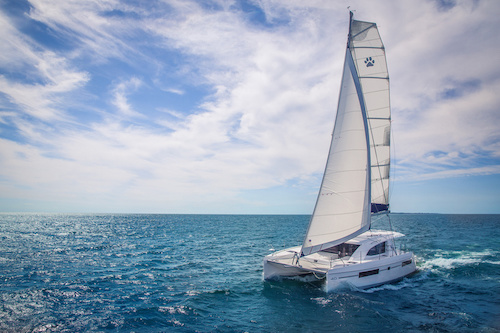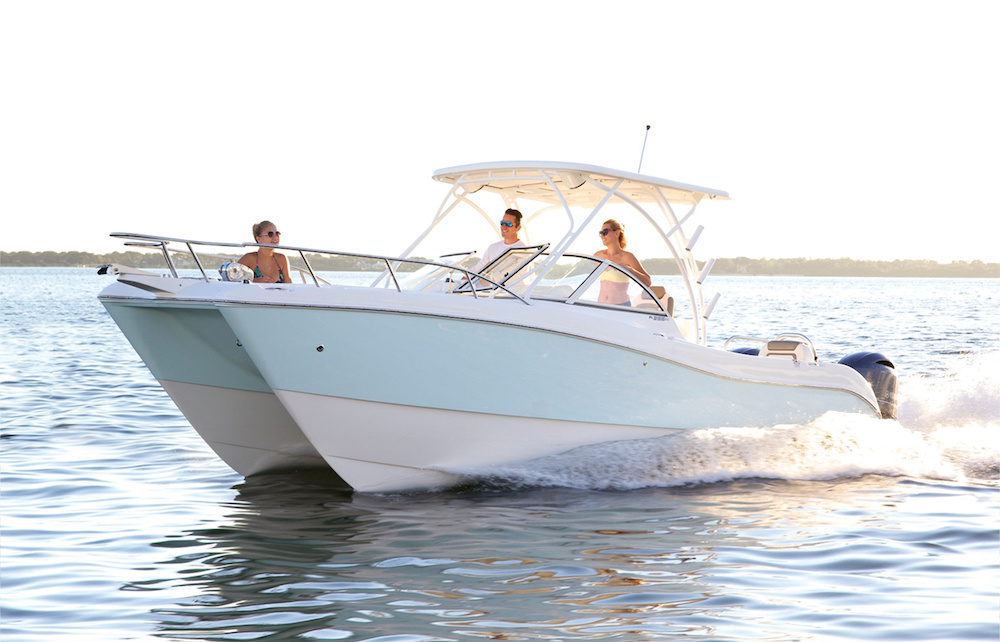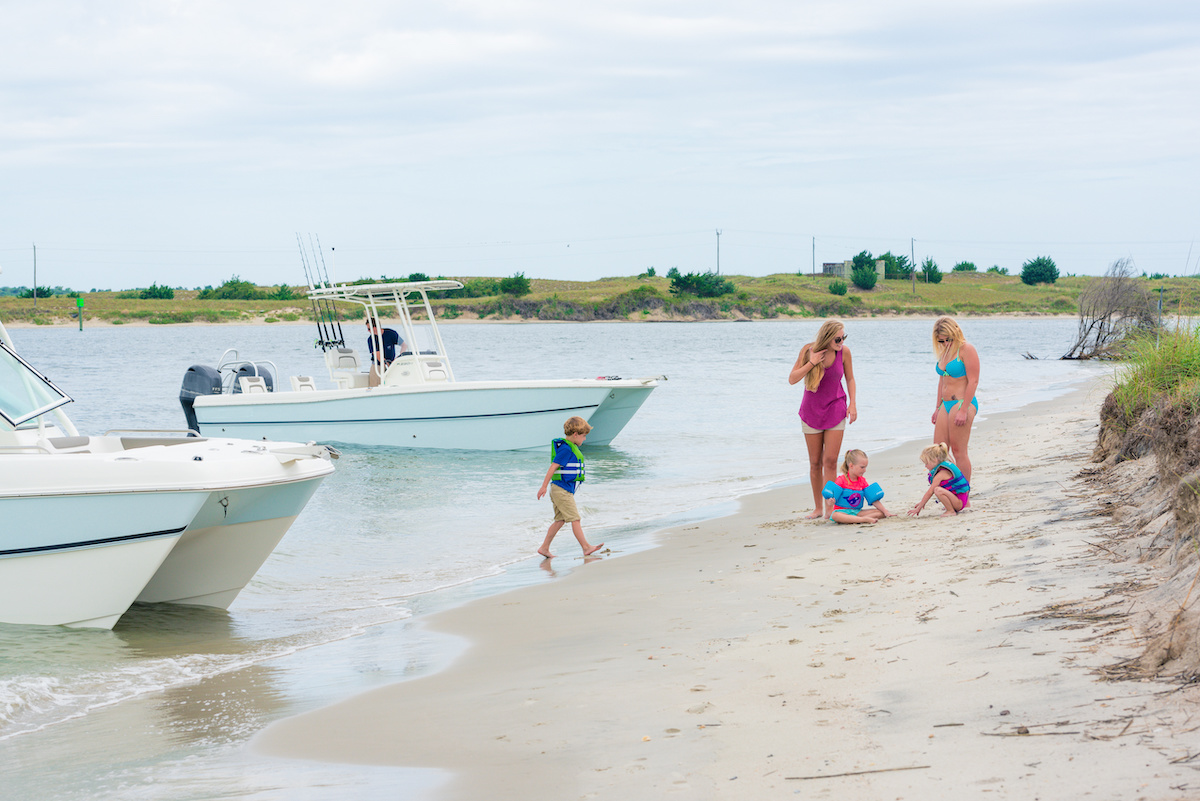What is a catamaran? In simplest terms, a catamaran is defined as a boat with two hulls. The term is derived from the Tamil word, kattumaram, which means logs bound together and the first of these designs were used for fishing. Far from their crude beginnings, today’s catamarans are usually fiberglass or carbon fiber constructions with twin hulls connected by a bridge deck and they’re designed in many sizes and for various activities. 
Let’s look at some of the types of catamarans and their best uses.
Sailing Catamarans
Sailing catamarans have made great strides over the past several decades. Small daysailing cats are popular because they provide a safe and simple learning platform and you’ll find fleets of them in resorts where they’re used by people with very little sailing experience. These types of small cats are usually made of roto-molded plastic or fiberglass and they typically don’t have auxiliary engines so their sole source of propulsion is sails.
Larger sailing cats have taken over the world of distance cruising and bareboat chartering. Nearly all tropically-based bareboat charter companies offer more sailing catamarans today than monohulls and those numbers are also growing in destinations such as the Mediterranean. Typically, charter cats have two engines, one in each hull, to maneuver as well as a mast that supports a mainsail and at least one headsail.
Explore Sailing Catamarans & Sailboats
Power Catamarans
Power catamarans, often referred to as "multi-hull powerboats" or "power cats," have larger engines than their sailing cousins and no masts or sails. Their bigger motors give them higher top speeds but these cats also need reinforced hulls to handle the weight and power of these engines. Other than pontoon boats (which arguably are also power cats), motorized cats are the fastest growing segment of the boating market.
Power cats come in various shapes and sizes. Numerous smaller power cat brands are marketed for fishing while larger ones are popping up in bareboat charter and as cruising platforms. Many commercial passenger ferries have also turned to the catamaran design for their spaciousness and speed.

Advantages of Catamaran Boats
There are some inherent advantages of boats with multiple hulls, which include:
- More deck and interior space per foot than monohulls. A catamaran has about 1.2 times the space of a monohull. In other words, a 40-foot cat should have the deck and interior space of a 50-foot monohull. Cats also have more interior space with up to four cabins even in a vessel under 40 feet in length. These large cabins usually provide easier berth access and they have hull windows with opening ports for better ventilation and light even in the staterooms, which are usually more separated for privacy.
- Due to their design with two hulls set wide apart, cats enjoy greater stability under way and at rest in rolly anchorages. Unlike a monohull that can heel under sail or roll when powered, cats stay level, which makes them safer and easier for people and pets to maneuver on the flat deck. Some say cats have an easier motion than monohulls and tend to induce less seasickness.
- With twin engines, cats’ propellers are set wide apart so these boats have excellent maneuverability. Cats can venture into shallower waters too – especially sailing cats that don’t have deep keels. Because cats don’t drag a massive keel through the water, they’re also on average 20-30 percent more fuel-efficient even with two engines.
- Larger, more sophisticated power and sailing catamarans have a natural redundancy built into their equipment inventory, which translates to comfort and safety. For example, if a fresh water pump fails in one hull, there’s usually another to provide water for washing up. If one engine fails or one propeller spins off, there’s another to get the vessel to homeport safely. There’s also more room for the installation of additional systems like generators, watermakers, battery banks, and more.
Drawbacks of Catamaran Boats
Like any boat type, there are a few small drawbacks when it comes to catamarans:
- Catamarans take up more space so it’s often difficult and expensive to find dock space.
- Due to their design, both power and sailing cats can also slam the bridge deck into oncoming waves when going to weather.
- Additionally, sailing cats don’t necessarily sail as well upwind as monohulls because with two hulls, they simply can’t point as high into the wind.
- Finally, it may be tempting to load up a catamaran due to the space it offers but a sure way to damage a power or sailing cat’s performance is to overload them or have uneven weight distribution—something, which is less of a problem on their monohull counterparts.
Catamaran Boats FAQs
Whether used for daysailing, world cruising, chartering or fishing, boats with two hulls are growing in acceptance and appeal. The basic design may be hundreds of years old but today’s updated designs make catamarans a viable option for any boater.
Are catamarans more expensive than monohulls?
Purchasing or chartering a catamaran is usually more expensive than a monohull since there are more accessories and even more fiberglass construction to pay for. Over time, cost of ownership can be higher too since there are two hulls to polish and wax and more equipment to service or replace. It’s also more expensive to haul out a catamaran for bottom work.
What is the typical draft of a catamaran?
Draft (depth below waterline) depends on the size and type of cat. Small daysailing cats can draw mere inches but with a large cruising cat, it may be 3-4 feet. Some cats have dagger boards that are used to improve upwind performance. With the boards down, a cat can draw 10 feet or more but these boards may be lifted to allow access to shallow water.
Can catamarans be raced?
Catamarans make fine racers as has been proven by the America’s Cup contenders. There are also one-design classes in the smaller, open designs.
Read Next: Types of Sailboats, Activities & Uses
You Might Also Like:
